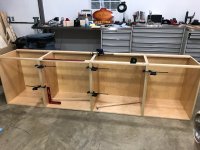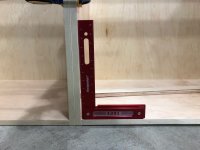- Joined
- Jan 28, 2017
- Messages
- 90
Hey guys, I'm building my first set of frameless cabinets using pre-finished maple ply for the carcasses. The ply I got from my lumber yard was supposed to be really nice stuff, but once I started cutting it, I started to notice that it wasn't as flat as the baltic birch that I am most comfortable using. I scrapped the bad stuff and used what I thought would be "good enough".
Now that it's all together, one of the carcasses has a pretty good bow to the inside. I figured that once I get these installed and all hooked together, the bow would work itself out. I decided to mock it all up in the shop using clamps. With everything tight, the bow seems to disappear, but it pulls one of the cabinets out of square by about an 1/8th of an inch.
In the pics attached, the two carcasses in the center will have doors while the two on the outside will have drawers.
My question is, is this enough out of square where it will cause issues with my doors and drawer fronts? I really don't wanna spend another $90 on a sheet of this crappy ply to fix the issue if I don't have to...
Frustrated, but still having fun...
BTW, notice the crappy edge banding... This is the first and last time I'll use FastEdge... I think I'm just a solid wood edge banding guy.
[attachimg=1]
Now that it's all together, one of the carcasses has a pretty good bow to the inside. I figured that once I get these installed and all hooked together, the bow would work itself out. I decided to mock it all up in the shop using clamps. With everything tight, the bow seems to disappear, but it pulls one of the cabinets out of square by about an 1/8th of an inch.
In the pics attached, the two carcasses in the center will have doors while the two on the outside will have drawers.
My question is, is this enough out of square where it will cause issues with my doors and drawer fronts? I really don't wanna spend another $90 on a sheet of this crappy ply to fix the issue if I don't have to...
Frustrated, but still having fun...
BTW, notice the crappy edge banding... This is the first and last time I'll use FastEdge... I think I'm just a solid wood edge banding guy.
[attachimg=1]


